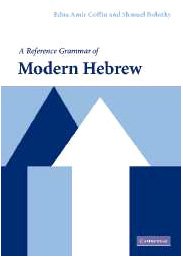

Most ebook files are in PDF format, so you can easily read them using various software such as Foxit Reader or directly on the Google Chrome browser.
Some ebook files are released by publishers in other formats such as .awz, .mobi, .epub, .fb2, etc. You may need to install specific software to read these formats on mobile/PC, such as Calibre.
Please read the tutorial at this link: https://ebookbell.com/faq
We offer FREE conversion to the popular formats you request; however, this may take some time. Therefore, right after payment, please email us, and we will try to provide the service as quickly as possible.
For some exceptional file formats or broken links (if any), please refrain from opening any disputes. Instead, email us first, and we will try to assist within a maximum of 6 hours.
EbookBell Team

0.0
0 reviews
ISBN 13: 9780521820332
Author: Edna Amir Coffin, Shmuel Bolozky
A Reference Grammar of Modern Hebrew provides a clearly-structured and accessible guide to all aspects of contemporary Hebrew grammar. Systematically organised, it presents the basic structures of the language, looking at grammatical categories, phrases, expressions, and the construction of clauses and sentences. Drawing on their extensive experience of teaching Hebrew to English-speaking students, the authors also provide a wide range of examples to illustrate each point, and introduce in a clear and accessible way the writing and pronunciation of the language, its punctuation rules, and its use in context. Wherever possible, equivalent Hebrew terminology is given to facilitate students' use of Hebrew language textbooks. Specialised linguistic terminology is kept to a minimum, and verb and noun tables are provided as well as a comprehensive index of terms, making this both a useful teaching resource and an easy-to-use reference tool for those wishing to look up specific details of the language.
Preliminary discussion
1.1 Parts of speech
1.2 Grammatical functions
1.3 Words and patterns
1.4 Gender and number
1.5 Open and closed word classes
1.6 Phrase constituents
1.7 Rules of agreement
Writing and pronunciation
2.1 Introduction
2.2 Consonants and corresponding sounds
2.3 The Hebrew vowel system
2.4 Texts with and without vowels
2.5 Diacritic marks other than vowels
2.6 Syllables
2.7 Stress patterns
2.8 Dialectal variation in consonant articulation
The verb system
3.1 Introduction: verb components
3.2 Citation forms
3.3 Verb tenses
3.4 Historical notes: Biblical tenses and aspects
3.5 Moods and verbal nouns
3.6 Verb pattern groups
3.7 Verb categorization
3.8 With and without linking verbs
3.9 Verbs with obligatory prepositions
3.10 Active, stative and inchoative verbs
Verb pattern groups
4.1 Verb pattern: pa'al
4.2 Verb pattern: nif'al
4.3 Verb pattern: pi'el
4.4 Verb pattern: pu'al
4.5 Verb pattern: hitpa'el
4.6 Verb pattern: hif'il
4.7 Verb pattern: huf'al
The noun system
5.1 Introduction to the noun system
5.2 Indefinite and definite noun forms
5.3 Gender features
5.4 Number features
5.5 Noun patterns
5.6 Nouns derived from verbs
5.7 Noun patterns associated with semantic features
5.8 Significant patterns with no semantic association
5.9 Acronyms
Pronouns
6.1 Forms of personal pronouns
6.2 Independent subject pronouns
6.3 Pronoun suffixes and prefixes in verbs and in existential expressions
6.4 Pronouns suffixed to nouns and prepositions
6.5 Demonstrative pronouns
6.6 Interrogative and relative pronouns
6.7 Impersonal pronouns
Numerals
7.1 Free counting
7.2 Cardinal numbers
7.3 Noun phrases with cardinal numbers
7.4 Ordinal numbers
7.5 Fractions
7.6 Multiplication values
7.7 Numeric value of letters
7.8 Phrases: days of the week, dates, telling time, age
Adjectives
8.1 Introduction: forming adjectives
8.2 Comparative and superlative adjectives
8.3 Forming adjectives by adding suffix –i
8.4 Nouns and adjectives of affiliation
8.5 Participles that function as adjectives
8.6 Special patterns
Adverbs and adverbial expressions
9.1 Introduction
9.2 Adverbs grouped according to form
9.3 Adverbs grouped according to function
9.4 Adverbs and ‘degree’ words
9.5 Sentential adverbs
Particles
10.1 Introduction
10.2 The particle ‘et’ before definite direct objects
10.3 Prepositions: prefixes, independent prepositions
10.4 Prepositions or adverbs?
10.5 Coordinating and correlative conjunctions
10.6 Subordinators
10.7 Exclamation particles and expressions
Noun phrases
11.1 Introduction to noun phrases
11.2 Noun phrase: noun + adjective
11.3 Comparative and superlative adjectives
11.4 Apposition noun phrases
11.5 Construct phrases
11.6 Phrases of possession
11.7 Phrases with demonstrative pronouns
11.8 Prepositional phrases
11.9 Numerical and quantifier phrases
11.10 Noun phrases with determiners
11.11 Gerunds and infinitives in noun phrases
Verb phrases
12.1 Introduction to verb phrases
12.2 Verb phrases: verbs and objects
12.3 Compound verb phrases
12.4 Grouping verbs by semantic considerations
12.5 Modal verbs
12.6 Habitual aspect phrases
12.7 Subjunctive and possibility phrases
Modal verbs and expressions
13.1 Introduction to modality
13.2 Modal verb phrases
13.3 Impersonal modal expressions
13.4 Temporal aspects in modality
13.5 Modality expressed by phrases with
Clauses and sentences
14.1 Introduction
14.2 Verbal sentences
14.3 Nominal sentences
14.4 Equational sentences
14.5 Existential sentences
14.6 Sentences of possession
14.7 Elliptical sentences
14.8 Classification of sentences by function
14.9 Sentence classification by structure
14.10 Simple sentences
14.11 Coordinate/compound sentences
14.13 Complement clauses
14.14 Attributive clauses
14.15 Relative clauses
14.16 Adverbial clauses
14.17 Conditional sentences
14.18 Integrated sentences
Language in context
15.1 Introduction
15.2 Sentence or utterance?
15.3 Topic and comment
15.4 Focus and topic
15.5 Deixis – reference to person, time and place
15.6 Reported speech – direct and indirect
15.7 Language registers
15.8 Genres of text
15.9 Cohesion and coherence of text
15.10 Language in context: sample texts
ference grammar of modern hebrew pdf
what is modern hebrew
a modern grammar for biblical hebrew pdf
a modern grammar for biblical hebrew
modern hebrew grammar pdf
a biblical hebrew reference grammar
Tags: Edna Amir Coffin, Shmuel Bolozky, Grammar